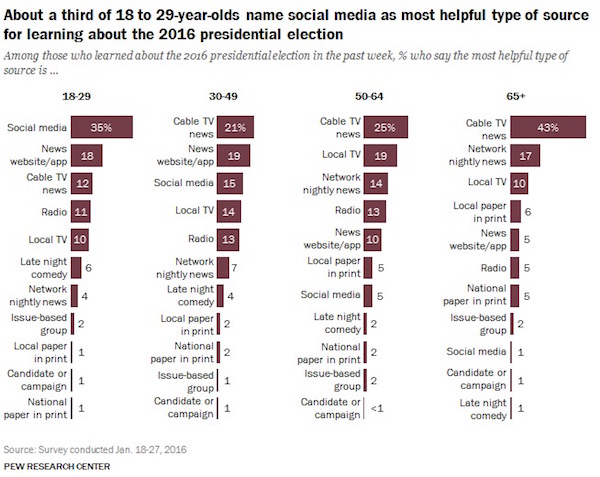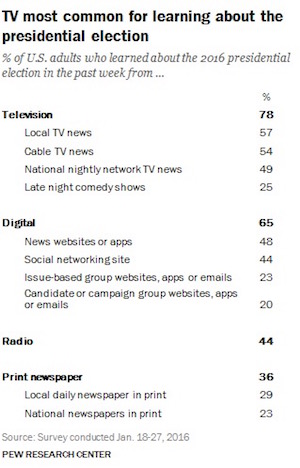 More than 90 percent of American adults followed the 2016 presidential election in some medium or another last week, according to a report released today by the Pew Research Center.
More than 90 percent of American adults followed the 2016 presidential election in some medium or another last week, according to a report released today by the Pew Research Center.
Among survey respondents who said they had learned about the election, 24 percent said cable news was the most helpful way for them to follow the campaign. The next most helpful: social media and local TV, each at 14 percent. Only 3 percent of respondents said the print edition of a local newspaper was the most helpful way to follow the campaign, and just 2 percent said the same for national print papers.
Pew found significant generational differences in how Americans are learning about the election. Take cable TV: 43 percent of those 65 and older said it was their most helpful source of campaign news, compared to only 12 percent for 18- to 29-year-olds. That younger cohort was much more reliant on social media, with 35 percent of respondents saying that was the most helpful way to follow the campaign. That’s about double the next highest source for that age group, news apps or sites.

Party identification also leads to differences over the value of cable news: 34 percent of Republicans, 24 percent of independents, and 19 percent of Democrats called cable most helpful. Democrats were more likely to rely on local TV news than Republicans or independents.
Still, most U.S. adults get news about the presidential election from more than one source. The survey found that 45 percent of respondents learned about the election from more than five sources in a week. Only 9 percent used just one source.
 TV was the most popular way of learning about the election, with 78 percent saying they followed the election in either local TV news, cable TV news, the national nightly news, or late night comedy shows. That beat out digital at 65 percent of U.S. adults.
TV was the most popular way of learning about the election, with 78 percent saying they followed the election in either local TV news, cable TV news, the national nightly news, or late night comedy shows. That beat out digital at 65 percent of U.S. adults.
Print newspapers were the least popular popular way to follow the election, the report said, with only 36 percent of respondents saying they had gotten election news from one in the past week, though that doesn’t mean readers aren’t consuming newspaper election coverage online:
The survey specifically asked about the print version of the paper and does not include the representation of newspapers in the digital space (48% of Americans got election news and information from news websites or apps in past week). This is an important distinction, as newspaper properties make up three of the top 10 digital news entities, according to comScore data compiled for our annual State of the News Media report. But it does speak to the precipitous decline of print as a mode of news — even as print-only consumers remain a key part of newspapers’ audiences.
While 44 percent of American adults learned about the election on social media, the study found that among those that use social media, users are more likely to read about the election than share information about it. About half of users learned about the election from social media, but just 18 percent took the next step to share content about the election. Lower-income social media users were more likely to share election news on social media, the study found — “about 20% of social networking users with household incomes under $75,000, compared with 14% of those with incomes of $75,000 or more,” it said.
Leave a comment